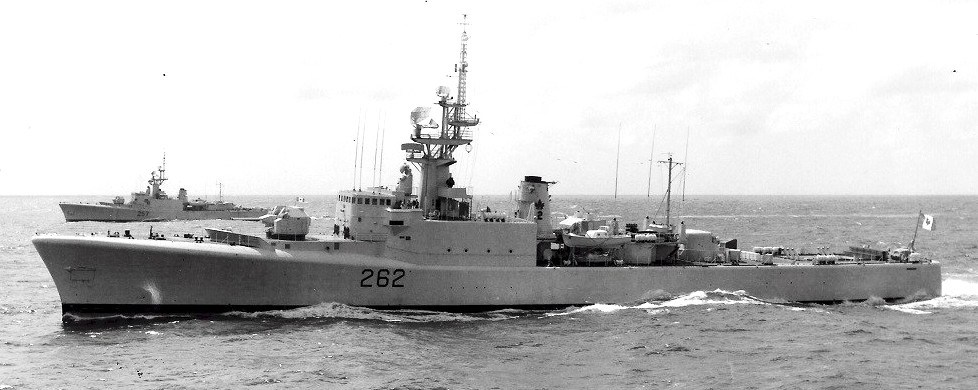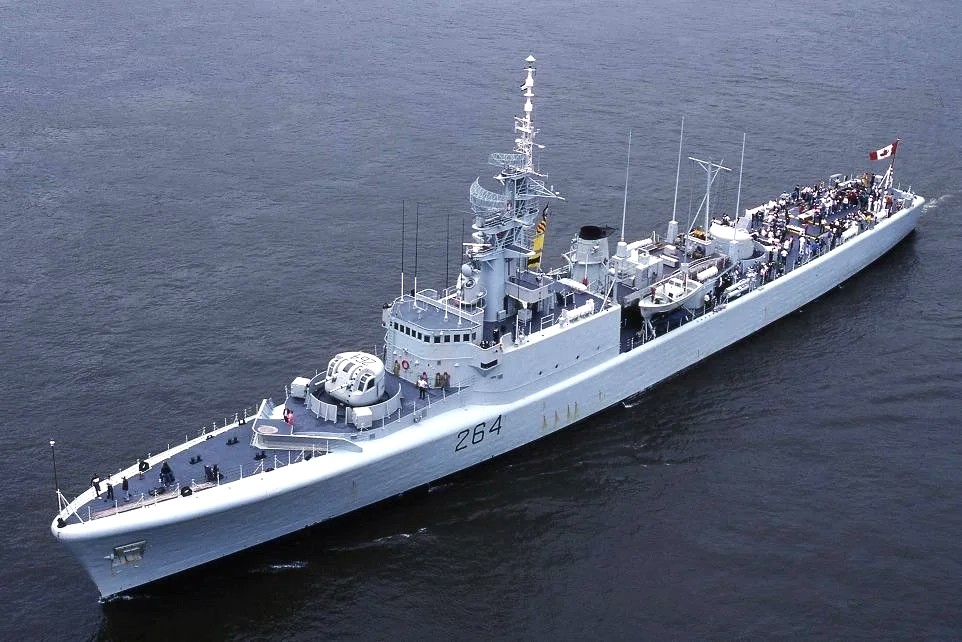Royal Canadian Navy Destroyers (Mackenzie Class): HMCS Mackenzie (DDE 261), HMCS Saskatchewan (DDE 262), HMCS Yukon (DDE 263), and HMCS Qu'Appelle (DDE 264)
Royal Canadian Navy Destroyers (Mackenzie Class)
_off_San_Diego_1992.jpg)
(USN Photo)
Royal Canadian Navy Mackenzie-class destroyer escort, HMCS Mackenzie (DDE 261), passing along San Diego, California (USA). The ship was participating in the exercise "RIMPAC '92".
The Mackenzie-class destroyer was a class of warship used by the Royal Canadian Navy and Canadian Forces from the 1960s–1990s. Six such ships were envisioned, of which four were completed to this specification. The last two hulls were completed to the post DDH conversion St. Laurent-class design (which included helicopter hangars); they were designated as the Annapolis class instead. The four Mackenzie-class destroyers spent most of their service in the Pacific Ocean, used primarily in a training role. Their only significant update was the DELEX (destroyer life extension) program, which was completed between 1982 and 1985 and updated their navigational radar and their sonar.
The Mackenzie class was an offshoot of the St. Laurent-class design. Initially planned to be an improved version of the design, budget difficulties led to the Canadian government ordering a repeat of the previous Restigouche class, with improved habitability and better pre-wetting, bridge and weatherdeck fittings to better deal with extreme cold. The original intention was to give the Mackenzie class variable depth sonar during construction, but would have led to delays of up to a year in construction time, which the navy could not accept.
The Mackenzie-class vessels measured 366 feet (112 m) in length, with a beam of 42 feet (13 m) and a draught of 13 feet 6 inches (4.11 m). The Mackenzies displaced 2,880 tonnes (2,830 long tons) fully loaded and had a complement of 290. The class was powered by two Babcock & Wilcox boilers connected to the two-shaft English-Electric geared steam turbines creating 30,000 shaft horsepower (22,000 kW). This gave the ships a maximum speed of 28 knots (52 km/h; 32 mph).
The most noticeable change for the Mackenzies was the replacement of the forward 3-inch (76 mm)/50 caliber Mk 22 guns of the St. Laurent design with a dual Vickers 3-inch/70 caliber Mk 6 gun mount and the presence of a fire-control director atop the bridge superstructure. The bridge was raised one full deck higher than on previous classes in order to see over the new gun mount. The class did retain the rear dual 3-inch/50 caliber gun mount and for anti-submarine warfare, the class was provided with two Mk 10 Limbo mortars. The ships were initially fitted with Mark 43 torpedoes to supplement their anti-submarine capability, but were quickly upgraded to the Mark 44 launched from a modified depth charge thrower. This was to give the destroyers the ability to combat submarines from a distance.
The Mackenzie class were equipped with one SPS-12 air search radar, one SPS-10B surface search radar and one Sperry Mk. 2 navigation radar.[4] For detection below the surface, the ships had one SQS-501 high frequency bottom profiler sonar, one SQS-503 hull mounted active search sonar, one SQS-502 high frequency mortar control sonar and one SQS-11 hull mounted active search sonar.The DEstroyer Life EXtension (DELEX) refit was born out of the need to extend the life of the steam-powered destroyer escorts of the Canadian Navy in the 1980s until the next generation of surface ship was built. Encompassing all the classes based on the initial St. Laurent (the remaining St. Laurent, Restigouche, Mackenzie, and Annapolis-class vessels), the DELEX upgrades were meant to improve their ability to combat modern Soviet submarines, and to allow them to continue to operate as part of NATO task forces.
The DELEX refit for the Mackenzie class was the same for the Improved Restigouche-class vessels. This meant that the ships would receive the new tactical data system ADLIPS, new radars, new fire control and satellite navigation. They exchanged the SQS-503 sonar for the newer SQS-505 model.They also received a triple mount for 12.75-inch (324 mm) torpedo tubes that would use the new Mk 46 homing torpedo. The Mark 46 torpedo had a range of 12,000 yards (11,000 m) at over 40 knots (74 km/h; 46 mph) with a high-explosive warhead weighing 96.8 pounds (43.9 kg).
Mackenzie was ordered in 1957 and was laid down on 15 December 1958 at Canadian Vickers Ltd., Montreal. The ship was launched on 25 May 1961 and was commissioned into the RCN on 6 October 1962 with the classification number DDE 261.Assigned to the Atlantic Fleet based at Halifax, Mackenzie transferred to the Pacific on 2 March 1963. She was assigned to the Pacific Fleet as a member of the Fourth Canadian Destroyer Squadron and served largely as a training ship with the RCN and later in the Canadian Forces under Maritime Forces Pacific as part of Training Group Pacific. She was also used for surveillance of the west coast, like in March 1973, when she intercepted drug smugglers off Quatsino Sound. In July 1982, Mackenzie shadowed the Soviet spy ship Aavril Sarychev in Canadian waters which had monitoring the North American west coast for new American submarines. She underwent the DELEX refit between 25 May 1986 and 16 January 1987.
Mackenzie was paid off from Maritime Command on 3 August 1993. Mackenzie's hulk was purchased by the Artificial Reef Society of British Columbia (ARSBC) in March 1995 for $200,000.[17] She was stripped in spring/summer 1995 of environmental contaminants and scuttled on 16 September 1995 near Isle-de-Lis and Gooch Island, in the Georgia Strait off Sidney, British Columbia. She rests on clay and rock with a 20° list to port. Wikipedia)
_at_San_Diego_1992.jpg)
(USN Photo)
The Royal Canadian Navy Mackenzie-class destroyer escort, HMCS Mackenzie (DDE 261), as it sails past the San Diego Convention Center at San Diego, California (USA). The ship was participating in the exercise "RIMPAC '92".

(RCN Photo)
HMCS Mackenzie (DDE 261).

(RCN Photo)
HMCS Mackenzie (DDE 261), in the Esquimalt Harbour approaches.

(RCN Photo)
HMCS Mackenzie (DDE 261), conducts a jack-stay personnel transfer with Canadian Improved Restigouche Class Destroyer.

(Ships Nostalgia Photo)
HMCS Mackenzie (DDE 261),

(RCN Photo)
HMCS Saskatchewan (DDE 262), was the second Canadian naval unit to bear the name HMCS Saskatchewan. The ship was named for the Saskatchewan River which runs from Saskatchewan to Manitoba in Canada. Entering service in 1963, she was mainly used as a training ship on the west coast. She was decommissioned in 1994 and sold for use as an artificial reef. She was sunk as such in June 1997 off British Columbia.

(RCN Photo)
HMCS Saskatchewan (DDE 262).

(Walter E. Frost/City of Vancouver archives Photo)
HMCS Saskatchewan (DDE 262).

(RCN Photo)
HMCS Saskatchewan (DDE 262).

(RCN Photo via Brian Dobing)
HMCS Saskatchewan (DDE 262).

(RCN Photo)
HMCS Yukon (DDE 263) was the first Canadian naval unit to carry the name. She was named for the Yukon River that runs from British Columbia through Yukon and into Alaska in the United States. Entering service in 1963, she was primarily used as a training ship on the west coast. She was decommissioned in 1993 and sold for use as an artificial reef and sunk as such at Sunken Harbor off San Diego, California in 2000.

(RCN Photo)
HMCS Yukon (DDE 263)

(Ships Nostalgia Photo)
HMCS Yukon departing Auckland 2/11/1982.

(RCN Photo)
HMCS Yukon (DDE 263).

(RCN Photo)
HMCS Yukon (DDE 263).

(RCN Photo)
HMCS Yukon (DDE 263) in Vancouver prior to commissioning. Note that she is not flying an ensign or commissioning pennant.

(RCN Photo via Bob Dobing)
HMCS Qu'Appelle (DDE 264) was the second Canadian naval unit to carry the name HMCS Qu'Appelle. Qu'Appelle was named for the Qu'Appelle River which runs through Saskatchewan and Manitoba in Canada. Entering service in 1963, the ship was largely used as a training ship on the west coast. She was decommissioned in 1994 and sold for scrapping.

(RCN Photo)
HMCS Qu'Appelle (DDE 264)

(Ships Nostalgia Photo)
HMCS Qu'Appelle (DDE 264).

(RCN Photo)
HMCS Qu'Appelle (DDE 264).

(RCN Photo)
HMCS Qu'Appelle (DDE 264).

(RCN Photo)
HMCS Qu'Appelle (DDE 264).

(RCN Photo)
HMCS Qu'Appelle (DDE 264).

